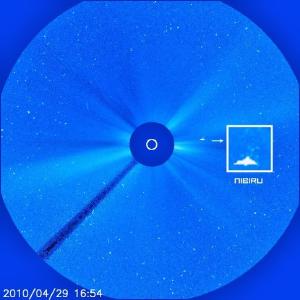Post
The Death Star
10 June 2013
While doing a bit of background research on the Kozai mechanism for yesterday’s post, I kept running into mention of a mysterious object known as Nibiru. The Kozai mechanism is pretty esoteric, so seeing it mentioned in blog articles is a bit odd. Being curious, I followed the internet trail of Nibiru, and down the rabbit hole of the weird.
If you’re a Star Trek fan you might be familiar with Nibiru as the planet from the opening scene of the latest movie, but this Nibiru is supposed to be a planet heading for a collision course with Earth in the near future. The evidence for Nibiru comes from one Nancy Leider, who claimed to have gotten the information from gray aliens from Zeta Reticuli who communicate with her via a chip they implanted in her brain.
 SOHO
SOHOSince Nibiru is a term in Babylonian astronomy meaning the highest point of a star or planet in the sky, the mention of Nibiru in texts such as the Enuma Elis have been taken as evidence that the ancients knew of this planet. Most significantly, Zecharia Sitchin promotes the idea in his book The Twelfth Planet. This isn’t some self-published book. It was published by Harper in 1976 by HarperCollins, is still in press, and is ranked 51 on Amazon’s Astronomy and Space Science category. (Good golly I need to write a popular science book).
So what scientific evidence might support this claim? Absolutely none. The claim is, in fact, provably wrong. If an Earth-mass or larger object were approaching Earth, we would have detected it by now. We have, for example, made several all-sky surveys, including infrared surveys. Not to mention the army of amateur astronomers looking for comets and the like. Even if Nibiru were in a very elliptical orbit, we would have found it by now given its supposed size. There is no planet on a collision course with Earth.
And yet this idea won’t die.